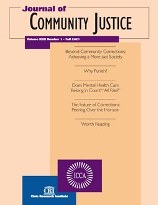Effectiveness of Community Supervision: Incorporating Evidence-Based Practices into a Nation’s Obsession with Supervision
Author: Haley Tiernan.; April N. Terry.
Source: Volume 33, Number 02, Winter 2024 , pp.4-8(5)

next article > |return to table of contents
Abstract:
Community supervision is an intermediate sanction regularly used by the U.S. juvenile and criminal justice systems. At the end of 2020, 3,053,700 individuals were on probation in the United States. Supervision “success” is generally measured as a client’s ability to fulfill the conditions of his or her supervision and to avoid reoffending. Unfortunately, recidivism rates are commonly high among probationers. Reviewing the “What Works” literature, however, can provide practitioners and decision makers with evidence-based practices for working with probationers, resulting in increased rates of successful termination of supervision. Training community supervision officers on evidence-based programs using the risk-need-responsivity (RNR) model helps officers to identify clients’ risks and needs and then to match them with the correct types and intensity of treatment(s). Adherence to the fidelity of these models should subsequently increase supervision success rates.Keywords: Criminal justice system, community supervision, probation, what works, Risk-need-responsivity (RNR) model
Affiliations:
1: Fort Hays State University; 2: Fort Hays State University.